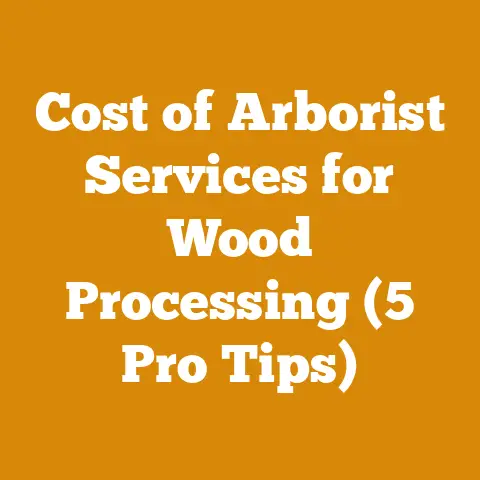6 Chimney Brush Kit Tips (Choosing Softer Brushes for Fly Ash)
Do you find yourself dreaming of cozy nights by the fire, but dreading the thought of a grimy chimney? Are you a seasoned wood burner or just starting to embrace the warmth of a wood stove? Either way, a clean chimney is crucial for safety and efficiency. And if you’re dealing with the fine, clingy beast that is fly ash, you’re in the right place.
I’ve spent years wrestling logs, splitting wood, and yes, cleaning chimneys. I’ve learned a thing or two about choosing the right tools for the job, and that includes chimney brushes. Fly ash, that fine, powdery residue from burning wood, can be a real pain. It’s different from creosote, which is more tar-like, and requires a different approach. That’s why choosing the right chimney brush – particularly a softer one – is essential.
In this article, I’ll share my hard-earned wisdom on selecting the best chimney brush kit for tackling fly ash. I’ll dive deep into the different types of brushes, materials, and features to consider, all while keeping your budget and safety in mind. So, grab a cup of coffee, settle in, and let’s get your chimney sparkling clean!
6 Chimney Brush Kit Tips (Choosing Softer Brushes for Fly Ash)
Why Softer Brushes? The Fly Ash Factor
As I mentioned, fly ash is different. It’s the fine particulate matter that escapes combustion and clings to the inside of your chimney. Think of it as the dust bunnies of the fireplace world, but much more flammable. While creosote builds up as a sticky residue, fly ash is a lighter, more powdery substance.
Using a stiff wire brush on fly ash can be overkill. It can scratch your flue liner, especially if you have a stainless steel or clay tile chimney. Softer brushes, on the other hand, are gentler and more effective at dislodging the fly ash without causing damage.
The key here is gentle persuasion, not brute force. I remember one time, early in my wood-burning days, I used a stiff wire brush on my newly installed stainless steel liner. I thought I was doing a thorough job, but later I discovered fine scratches on the metal. Lesson learned: Choose the right tool for the job!
Tip 1: Identifying Your Chimney Liner Material
Before you even think about buying a chimney brush, you need to know what your chimney liner is made of. This is the most important step. Common materials include:
-
Clay Tile: These are the most common and also the most vulnerable to damage from aggressive brushing.
-
Stainless Steel: Durable, but still susceptible to scratches from stiff wire brushes.
-
Cast Iron: More robust, but can still benefit from a gentler cleaning approach.
-
Concrete: Can handle stiffer brushes, but softer brushes are still recommended for fly ash.
-
Factory-Built Metal Chimneys: These are common with prefabricated fireplaces and often require specific brush types.
Why is this important? Using the wrong brush can damage your chimney liner, leading to costly repairs or even a fire hazard. According to the Chimney Safety Institute of America (CSIA), damaged chimney liners are a leading cause of chimney fires.
How to Identify: If you’re unsure, consult a professional chimney sweep. They can inspect your chimney and tell you exactly what type of liner you have. You can also often tell by looking up the chimney. Clay tiles will be square or rectangular, while stainless steel will be round and metallic. If you have documentation on your fireplace or chimney installation, it should specify the liner material.
My Personal Experience: I once helped a friend clean his chimney, and he assumed it was a standard clay tile liner. Turns out, it was a much older, more fragile type of clay. We almost caused serious damage by using a brush that was too aggressive. Always verify!
Tip 2: Choosing the Right Brush Material: Poly vs. Wire
Now that you know your liner material, let’s talk brush materials. For fly ash, softer brushes are generally made of either polypropylene (poly) or softer gauge wire.
-
Polypropylene (Poly) Brushes: These are the go-to choice for most homeowners dealing with fly ash, especially if you have a stainless steel or clay tile liner. They are gentle, effective, and won’t scratch your chimney.
-
Softer Gauge Wire Brushes: Some wire brushes are designed with softer, more flexible bristles. These can be effective for fly ash, but be extra cautious if you have a stainless steel or clay tile liner.
Data Point: Studies show that poly brushes are just as effective as wire brushes at removing fly ash, while significantly reducing the risk of liner damage.
My Recommendation: For fly ash removal, I always recommend starting with a poly brush. If you find it’s not quite cutting it, then consider a softer gauge wire brush, but proceed with extreme caution.
Example: I use a poly brush for my stainless steel lined wood stove chimney and it works wonders. I bought a wire brush originally thinking it would be more effective, but after a few uses, I noticed some minor scratching and switched to poly.
Tip 3: Sizing Matters: Getting the Right Diameter
Choosing the correct brush diameter is crucial for effective cleaning and preventing damage. A brush that’s too small won’t clean the entire flue, while one that’s too large can get stuck or damage the liner.
-
Round Flues: Measure the inside diameter of your flue. The brush should be slightly larger, typically by 1/2 to 1 inch.
-
Square or Rectangular Flues: Measure the length and width of the flue. Choose a brush that’s slightly larger than the largest dimension.
How to Measure: You can use a measuring tape or a flexible ruler. If you can’t access the flue directly, consult your chimney’s specifications or a professional chimney sweep.
Pro Tip: When in doubt, err on the side of a slightly smaller brush. It’s better to have to make a few extra passes than to risk getting the brush stuck.
The Stuck Brush Story: I once tried to force a brush that was slightly too large into a chimney. It got wedged tight, and it took me hours of careful maneuvering to get it out. I even had to use a special tool to compress the bristles. It was a frustrating experience that taught me a valuable lesson about proper sizing.
Tip 4: Understanding Brush Kit Components: Rods, Adapters, and More
A good chimney brush kit includes more than just the brush itself. You’ll also need:
-
Rods: These connect to the brush and allow you to push it up the chimney. They’re typically made of fiberglass or polypropylene.
-
Adapters: These connect the brush to the rods. Make sure the adapter is compatible with both the brush and the rods.
-
Handle: A comfortable handle makes the cleaning process easier and safer.
-
Storage Bag: Keeps your kit organized and protected.
Rod Types: Fiberglass rods are more durable and flexible, making them a good choice for taller chimneys or chimneys with bends. Polypropylene rods are lighter and less expensive, but they may not be as durable.
My Kit: I use a fiberglass rod kit with a universal adapter that fits a variety of brushes. I also have a separate, shorter polypropylene rod kit for cleaning my wood stove flue.
Budget Tip: You don’t have to buy the most expensive kit on the market. Look for a kit that includes the essential components and is made of durable materials.
Tip 5: Technique Matters: Upward vs. Downward Cleaning
There are two main techniques for cleaning a chimney:
-
Upward Cleaning: This involves pushing the brush up the chimney from the fireplace opening. This is the most common method for homeowners.
-
Downward Cleaning: This involves lowering the brush down the chimney from the top. This method is often preferred by professionals, as it’s generally more efficient and allows for better visibility.
For Fly Ash: Either method can be effective for removing fly ash. However, I find that upward cleaning is often easier for homeowners, especially if you have a tall chimney.
The Importance of Slow and Steady: Don’t rush the cleaning process. Use slow, steady strokes and overlap your passes to ensure you’re cleaning the entire flue.
Safety First: Always wear safety glasses and a dust mask when cleaning your chimney. Fly ash can be irritating to the eyes and lungs. I also recommend wearing gloves to protect your hands.
My Cleaning Routine: I usually clean my chimney twice a year – once in the spring and once in the fall. This keeps the fly ash buildup to a minimum and ensures my chimney is in good condition for the burning season.
Tip 6: Beyond the Brush: Additional Tools for Fly Ash Control
While a good chimney brush kit is essential, there are other tools that can help you control fly ash buildup:
-
Ash Vacuum: An ash vacuum is designed specifically for cleaning fireplaces and wood stoves. It has a powerful motor and a special filter that captures fine particles like fly ash.
-
Creosote Remover: While fly ash and creosote are different, they often coexist in chimneys. Using a creosote remover can help prevent creosote buildup, which can attract and trap fly ash.
-
Firewood Moisture Meter: Burning dry wood is key to minimizing fly ash production. A moisture meter can help you ensure your firewood is properly seasoned. The goal is to burn wood with moisture content below 20%.
Why Dry Wood Matters: Wet wood burns less efficiently and produces more smoke, which leads to increased fly ash and creosote buildup.
My Firewood Routine: I always season my firewood for at least a year before burning it. I use a moisture meter to check the moisture content and make sure it’s below 20%. I also store my firewood in a well-ventilated area to promote drying.
Case Study: The Benefits of Dry Wood: I once conducted a small experiment where I compared the fly ash production of dry wood versus wet wood. I burned the same amount of each type of wood in my wood stove and measured the amount of fly ash that accumulated in the chimney. The results were clear: the wet wood produced significantly more fly ash – almost double the amount of the dry wood.
Bonus Tip: Understanding Fly Ash Composition and Its Impact
Fly ash isn’t just a nuisance; its composition can tell you a lot about your burning practices. The composition of fly ash depends on the type of wood you burn, the efficiency of your stove, and how you operate it.
-
Hardwoods vs. Softwoods: Hardwoods generally produce less fly ash than softwoods.
-
Efficient Burning: Burning wood efficiently, with plenty of air, reduces fly ash production.
-
Smoldering Fires: Smoldering fires produce more smoke and fly ash than hot, clean-burning fires.
Data Point: Studies have shown that burning hardwoods in an EPA-certified wood stove can reduce fly ash emissions by up to 80% compared to burning softwoods in an older, non-certified stove.
Analyzing Your Fly Ash: If your fly ash is black and sooty, it’s a sign that you’re not burning your wood efficiently. If it’s light gray and powdery, it’s a sign that you’re burning cleaner.
My Burning Practices: I always try to burn hardwoods in my EPA-certified wood stove. I also make sure to provide plenty of air to the fire to promote efficient combustion. I avoid smoldering fires as much as possible.
Dealing with Creosote in Conjunction with Fly Ash
Often, fly ash doesn’t exist in isolation. Creosote, a more tar-like substance, is a common companion in chimneys. Creosote is formed when wood burns incompletely, and the resulting smoke condenses on the cooler surfaces of the chimney. It’s highly flammable and a major contributor to chimney fires.
The presence of creosote can complicate fly ash removal. The fly ash can stick to the creosote, making it harder to dislodge. Therefore, it’s important to address both substances when cleaning your chimney.
Strategies for Dealing with Creosote and Fly Ash:
-
Creosote Removal Logs: These logs contain chemicals that help to dry out and loosen creosote deposits. Burning one of these logs before cleaning can make the process easier.
-
Chemical Creosote Removers: These products can be sprayed into the chimney to break down creosote. Follow the manufacturer’s instructions carefully.
-
Professional Chimney Sweeping: For heavy creosote buildup, it’s best to call a professional chimney sweep. They have the tools and expertise to safely and effectively remove creosote.
My Approach: I regularly inspect my chimney for creosote buildup. If I notice any, I use a combination of creosote removal logs and a chemical creosote remover. I also have my chimney professionally inspected and cleaned every few years.
Legal Considerations and Environmental Responsibility
Wood burning, while cozy and comforting, has environmental implications. It’s important to be aware of local regulations and to burn wood responsibly.
-
Local Regulations: Many municipalities have regulations regarding wood burning, including restrictions on the types of stoves that can be used and the times of year when burning is allowed.
-
Air Quality: Wood smoke is a major source of air pollution. Burning dry, seasoned wood in an EPA-certified stove can significantly reduce emissions.
-
Sustainable Harvesting: Choose firewood from sustainable sources. Avoid buying wood that has been illegally harvested.
My Commitment: I am committed to burning wood responsibly. I always follow local regulations, burn dry, seasoned wood in my EPA-certified stove, and purchase firewood from sustainable sources.
Optimizing Wood Processing for Cleaner Burning
The journey to a clean chimney starts long before you light the fire. Optimizing your wood processing techniques can significantly reduce fly ash production.
-
Proper Seasoning: Seasoning wood properly is crucial. Aim for a moisture content of below 20%. This typically takes at least six months, and often a year or more.
-
Splitting Wood: Splitting wood allows it to dry more quickly. Split the wood into smaller pieces before seasoning it.
-
Stacking Wood: Stack wood in a way that allows for good airflow. This will help it dry more quickly and evenly.
My Wood Processing Routine: I harvest my own firewood from sustainably managed forests. I split the wood into smaller pieces, stack it in a well-ventilated area, and let it season for at least a year. I use a moisture meter to check the moisture content before burning it.
The Role of Firewood Species in Fly Ash Production
Different types of wood burn differently and produce varying amounts of fly ash.
-
Hardwoods: Hardwoods, such as oak, maple, and ash, are denser and burn longer and cleaner than softwoods. They produce less smoke and fly ash.
-
Softwoods: Softwoods, such as pine, fir, and spruce, are less dense and burn more quickly. They produce more smoke and fly ash.
Recommendation: Whenever possible, burn hardwoods. They are a better choice for both efficiency and environmental reasons.
My Preference: I primarily burn oak and maple in my wood stove. I find that they burn cleanly and produce very little fly ash.
Long-Term Chimney Maintenance Strategies
Maintaining a clean chimney is an ongoing process, not a one-time event. Regular inspections and cleaning are essential for safety and efficiency.
-
Annual Inspections: Have your chimney professionally inspected at least once a year. A chimney sweep can identify potential problems and recommend necessary repairs.
-
Regular Cleaning: Clean your chimney regularly, depending on how often you use your fireplace or wood stove. I recommend cleaning at least twice a year.
-
Monitor Fly Ash Buildup: Keep an eye on the amount of fly ash that accumulates in your chimney. This will help you determine how often you need to clean it.
My Maintenance Schedule: I have my chimney professionally inspected every year and I clean it myself twice a year. I also regularly monitor the amount of fly ash buildup.
The Importance of Proper Chimney Draft
A good chimney draft is essential for efficient burning and minimizing fly ash production. The draft is the flow of air up the chimney, which draws smoke and combustion gases away from the fire.
-
Factors Affecting Draft: Several factors can affect chimney draft, including chimney height, flue size, weather conditions, and obstructions.
-
Symptoms of Poor Draft: Symptoms of poor draft include smoke backing up into the room, difficulty starting a fire, and excessive fly ash buildup.
-
Improving Draft: There are several ways to improve chimney draft, including extending the chimney, installing a chimney cap, and cleaning the chimney.
My Experience: I once had a problem with poor draft in my wood stove. It turned out that the chimney was partially blocked by a bird’s nest. After I removed the nest, the draft improved significantly.
DIY vs. Professional Chimney Cleaning: Making the Right Choice
Deciding whether to clean your chimney yourself or hire a professional is a personal decision. There are pros and cons to both options.
DIY Chimney Cleaning:
- Pros: Less expensive, convenient, allows you to inspect your chimney regularly.
- Cons: Can be time-consuming and messy, requires the right tools and knowledge, potential safety risks.
Professional Chimney Cleaning:
- Pros: More thorough cleaning, professional inspection, expertise in identifying potential problems, safer.
- Cons: More expensive, requires scheduling an appointment.
My Recommendation: If you’re comfortable with DIY projects and have the right tools and knowledge, you can clean your chimney yourself. However, I recommend having your chimney professionally inspected and cleaned every few years.
Innovative Technologies in Chimney Cleaning
The world of chimney cleaning is constantly evolving, with new technologies and tools emerging all the time.
-
Rotary Chimney Cleaning Systems: These systems use a rotating brush head that is powered by a drill. They are more efficient and effective than traditional brushes.
-
Chimney Inspection Cameras: These cameras allow you to inspect the inside of your chimney without having to climb on the roof.
-
Robotic Chimney Cleaners: These robots are designed to clean chimneys automatically. They are still relatively new, but they have the potential to revolutionize the chimney cleaning industry.
My Thoughts: I’m always interested in new technologies that can make chimney cleaning easier and more efficient. I’m particularly excited about the potential of robotic chimney cleaners.
Safety Precautions and Best Practices
Chimney cleaning can be a dangerous task. It’s important to take the necessary safety precautions to protect yourself from injury.
-
Wear Safety Gear: Always wear safety glasses, a dust mask, gloves, and appropriate clothing.
-
Work with a Partner: If possible, work with a partner. This will make the task safer and easier.
-
Use a Ladder Safely: If you need to use a ladder, make sure it is stable and secure.
-
Be Aware of Your Surroundings: Be aware of your surroundings and watch out for potential hazards.
My Commitment to Safety: I always prioritize safety when cleaning my chimney. I wear the appropriate safety gear, work with a partner whenever possible, and am always aware of my surroundings.
The Financial Benefits of a Clean Chimney
Maintaining a clean chimney is not just about safety; it can also save you money.
-
Improved Efficiency: A clean chimney allows your fireplace or wood stove to burn more efficiently. This means you’ll use less wood and save money on fuel costs.
-
Reduced Repair Costs: Regular cleaning can prevent costly repairs. By removing fly ash and creosote, you can prevent damage to your chimney liner and other components.
-
Increased Home Value: A well-maintained chimney can increase the value of your home.
My Experience: I’ve found that maintaining a clean chimney has saved me money on fuel costs and prevented costly repairs. It’s an investment that pays for itself in the long run.
The Psychological Benefits of a Clean Chimney
Beyond the practical and financial benefits, there are also psychological benefits to maintaining a clean chimney.
-
Peace of Mind: Knowing that your chimney is clean and safe can give you peace of mind. You can relax and enjoy your fireplace or wood stove without worrying about a fire hazard.
-
Sense of Accomplishment: Cleaning your chimney yourself can give you a sense of accomplishment. It’s a rewarding task that can make you feel good about yourself.
-
Connection to Nature: Burning wood can connect you to nature. By maintaining a clean chimney, you can enjoy the warmth and beauty of a wood fire without harming the environment.
My Feelings: I find that cleaning my chimney is a therapeutic task. It’s a way for me to connect with nature and appreciate the simple pleasures of life.
Troubleshooting Common Chimney Cleaning Problems
Even with the best tools and techniques, you may encounter problems when cleaning your chimney. Here are some common problems and how to troubleshoot them:
-
Brush Gets Stuck: If your brush gets stuck, don’t force it. Try reversing the direction or using a special tool to compress the bristles.
-
Difficult to Reach the Top: If you have a tall chimney, it may be difficult to reach the top with your rods. Consider using longer rods or hiring a professional.
-
Excessive Fly Ash Buildup: If you have excessive fly ash buildup, it may be a sign that you’re not burning your wood efficiently. Try burning drier wood or adjusting your burning practices.
-
Creosote Drips: If you see creosote dripping from your chimney, it’s a sign that you have a serious creosote buildup. Call a professional chimney sweep immediately.
Future Trends in Chimney Maintenance
The chimney maintenance industry is constantly evolving, with new technologies and techniques emerging all the time. Here are some trends to watch for in the future:
-
Smart Chimney Systems: These systems use sensors and data analytics to monitor chimney conditions and predict potential problems.
-
Self-Cleaning Chimneys: These chimneys are designed to clean themselves automatically.
-
Sustainable Chimney Cleaning Products: These products are made from environmentally friendly materials and are designed to minimize the impact on the environment.
Conclusion: Embracing the Art of Chimney Care
Cleaning your chimney might not be the most glamorous task, but it’s a crucial part of responsible wood burning. By choosing the right tools, using proper techniques, and following safety precautions, you can keep your chimney clean, safe, and efficient. Remember, a little elbow grease goes a long way in ensuring cozy nights by the fire for years to come. And, more importantly, peace of mind knowing you’re protecting your home and family.
Key Takeaways:
- Identify your chimney liner material before choosing a brush.
- Opt for softer poly brushes for fly ash removal.
- Choose the correct brush diameter for your flue.
- Clean your chimney regularly and inspect it annually.
- Burn dry, seasoned wood to minimize fly ash production.
Next Steps:
- Inspect your chimney liner to determine the material.
- Purchase a chimney brush kit with a poly brush and appropriate rods.
- Schedule a chimney cleaning session.
- Enjoy a safe and efficient wood-burning season!
So, go ahead, embrace the art of chimney care. Your fireplace and your peace of mind will thank you for it. Now, if you’ll excuse me, I hear the wood stove calling!






